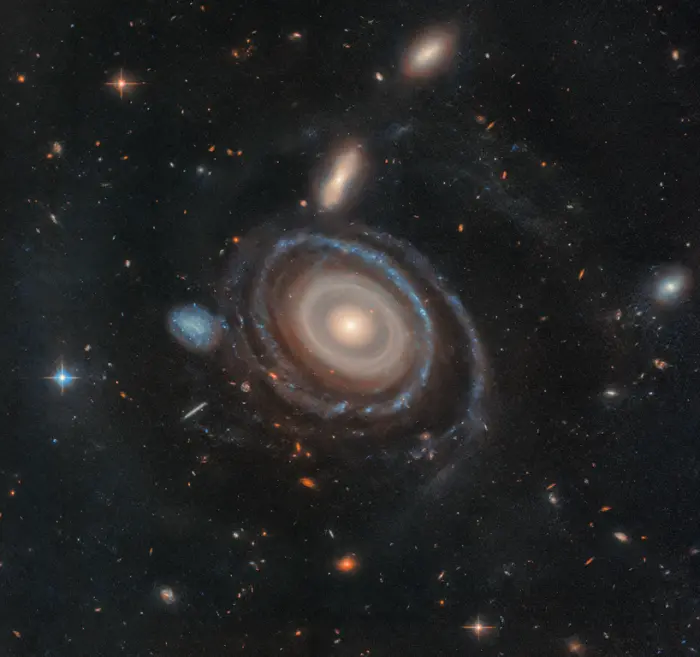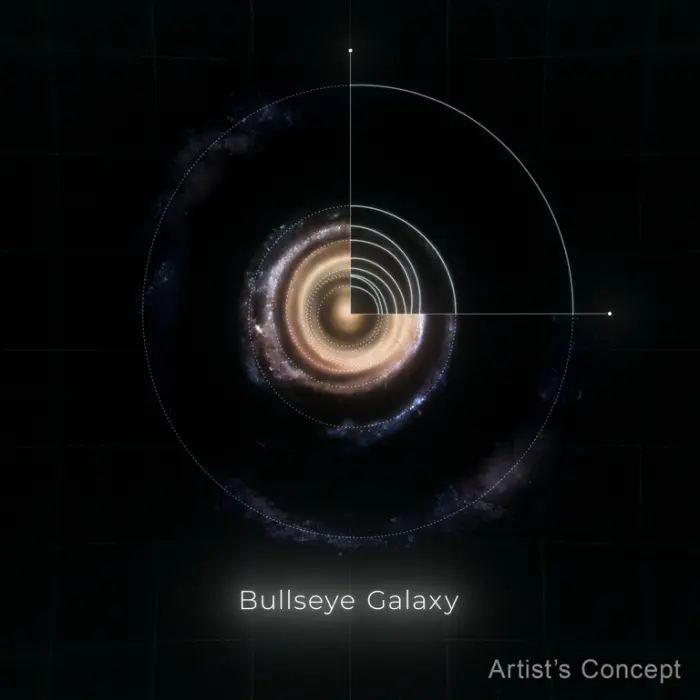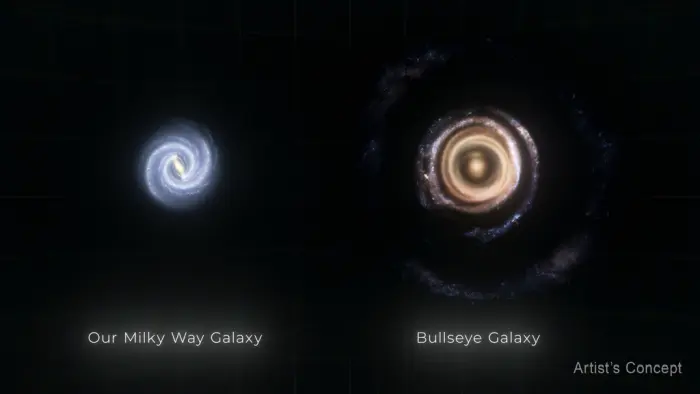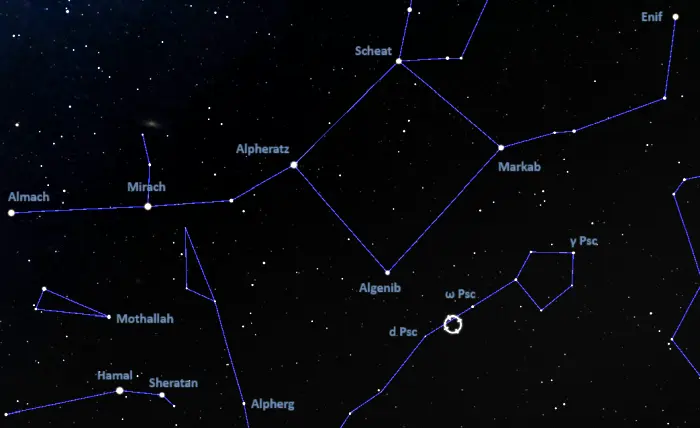The Bullseye Galaxy (LEDA 1313424) is a collisional ring galaxy (CRG) located approximately 534 million light-years away in the constellation Pisces. The galaxy is notable for having nine rings, more than any other galaxy discovered to date.
Ring galaxies are very rare and interesting objects. Notable for their circle-like appearance, these galaxies are believed to form either in collisions of two galaxies or due to bar instability in barred spiral galaxies. The rings are sites where many new stars form in a wave of star formation that moves through the galaxies.
The best-known examples of a ring galaxy are the Cartwheel Galaxy (ESO 350-40) in the constellation Sculptor, Hoag’s Object (PGC 54559) in Serpens, Mayall’s Object (Arp 148) in Ursa Major, the Fried Egg Galaxy (NGC 7742) in Pegasus, the Backward Galaxy (NGC 4622) in Centaurus, and the Lindsay-Shapley Ring (AM 0644-741) in Volans. Most of these galaxies have a single prominent ring.

LEDA 1313424, aptly nicknamed the Bullseye, is two and a half times the size of our Milky Way and has nine rings — six more than any other known galaxy. High-resolution imagery from NASA’s Hubble Space Telescope confirmed eight rings, and data from the W. M. Keck Observatory in Hawaii confirmed a ninth. Hubble and Keck also confirmed which galaxy dove through the Bullseye, creating these rings: the blue dwarf galaxy that sits to its immediate center-left. Image credit: NASA, ESA, Imad Pasha (Yale), Pieter van Dokkum (Yale) (PD)
Like the better-known Cartwheel Galaxy, the Bullseye Galaxy underwent a “bullseye” style collision with a smaller blue dwarf galaxy. The gravitational interaction between the two galaxies has produced concentric rings in the larger galaxy as material moved both inward and outward, triggering waves of star formation.
Like Hoag’s Object, the Bullseye Galaxy has an elliptical-like core and contains many point sources that may be star clusters. Spectroscopic observations of the core of the Bullseye have revealed that an active galactic nucleus (AGN) was triggered in the wake of the collision.
Astronomers had previously never found a galaxy with more than three rings. In late 2024, a research team at the National Observatory of Japan used the Subaru Telescope to capture the triple ring galaxy 2MASX J22361103+0124304, which lies around 800 million light-years away in Aquarius. This was an exceptionally rare discovery.
The record-holding Bullseye Galaxy was discovered by chance in Data Release 9 (DR9) of the DESI Legacy Imaging Surveys in 2019.
In 2025, a team of astronomers at the Yale University, the University of Toronto, and Swinburne University identified and measured the nine ring structures in the galaxy using images captured by the Hubble Space Telescope’s Advanced Camera for Surveys (ACS).
The researchers suspect that the galaxy may have had a tenth ring, but that the outermost ring has faded away. They estimate that the ring was three times farther out than the widest ring visible in the image taken by Hubble. The study was published in The Astrophysical Journal Letters on February 4, 2025.
LEDA 1313424 has six more rings than any other galaxy. Eight clear rings were identified using Hubble and a ninth ring was detected using data obtained at the W. M. Keck Observatory. Astronomers also used data from the Dragonfly Telephoto Array, designed to capture objects with very low surface brightness. Many of the rings are piled up near the galaxy’s core.

This illustration shows the massive galaxy nicknamed the Bullseye face-on. Dotted circles indicate where each of its rings are, which formed like ripples in a pond after a blue dwarf galaxy (not shown) shot through its core about 50 million years ago. NASA’s Hubble Space Telescope helped researchers carefully pinpoint the location of most of its rings, many of which are piled up at the center. Data from the W. M. Keck Observatory in Hawaii helped the team confirm another ring. Credit: NASA, ESA, Ralf Crawford (STScI) (PD)
Subsequent observations helped astronomers identify the smaller galaxy that passed through the centre of the Bullseye. The tiny interloper appears just to the left of the larger galaxy in the Hubble image. It shows strong starbursting activity, which indicates recent interaction with another galaxy.
The massive Bullseye is believed to have formed in a collision of a massive galaxy and the smaller dwarf galaxy around 56 million years ago. The two galaxies are still connected by a thin trail of gas even though they are 130,000 light-years apart. The gas extending between them was detected via spectroscopy using the Keck Cosmic Web Imager on the Keck Telescope on Maunakea, Hawaii.
Data from the Two Micron All Sky Survey (2MASS), obtained from 1997 to 2001, indicates an apparent major axis of 28.90 arcseconds and minor axis 10.23 arcseconds for LEDA 1313424. This corresponds to a physical size of 72,733 by 50,913 light-years (22.30 by 15.61 kiloparsecs).
More recent observations suggest that the Bullseye Galaxy is around 250,000 light-years across, or two and a half times larger than the Milky Way.
The nine rings will not last forever. Astronomers have captured the galaxy in the relatively short period of time after the impact. Simulations have shown that ring structures tend to dissolve over a few hundred million years. Even before the discovery of the Bullseye’s nine rings, models predicted that rings tend to move outward, gradually becoming more spaced out.
Astronomers suspect that the Bullseye Galaxy may end up as a giant low surface brightness spiral galaxy (GLSB) like Malin 1 in Coma Berenices. The Bullseye may be the first directly observed evidence of the evolution of a collisional ring galaxy into a GLSB. Observations show that the galaxy’s extended, faded rings may lead to extended features with low surface brightness.

This illustration compares the size of our own Milky Way galaxy to gargantuan galaxy LEDA 1313424, nicknamed the Bullseye. The Milky Way is about 100,000 light-years in diameter, and the Bullseye is almost two-and-a-half times larger, at 250,000 light-years across. Credit: NASA, ESA, Ralf Crawford (STScI) (PD)
Location
The Bullseye Galaxy lies in the constellation Pisces. It appears in the tail of the western fish of Pisces, near the magnitude 4.01 star Omega Piscium, east of the Circlet of Pisces.
Even though it lies close enough to the celestial equator to be theoretically visible from virtually anywhere, the Bullseye Galaxy is too faint to be visible in amateur telescopes.

Bullseye Galaxy location, image: Stellarium
Bullseye Galaxy – LEDA 1313424
| Constellation | Pisces |
| Object type | Collisional ring galaxy (CRG) |
| Morphological type | S |
| Right ascension | 00h 09m 39.4s |
| Declination | +07° 04′ 52″ |
| Apparent size | 0.62’ x 0.5’ |
| Distance | 534 ± 39 million light-years (163.6 ± 11.9 megaparsecs) 163.7 ± 2.2 megaparsecs |
| Redshift | 0.039414 ± 0.000827 |
| Heliocentric radial velocity | 11816 ± 248 km/s |
| Names and designations | Bullseye Galaxy, AGC 103748, LEDA 1313424, PGC 1313424, 2MASX J00093930+0704489, 2MASS J00093932+0704492, WISEA J000939.34+070449.2, NVSS J000939+070451 |